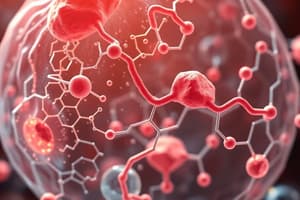Podcast
Questions and Answers
What is metabolism?
What is metabolism?
- A process that requires energy input
- The study of energy transformations
- A specific molecule altered in defined steps
- The totality of an organism's chemical reactions (correct)
What is a metabolic pathway?
What is a metabolic pathway?
A specific molecule which is altered in a series of defined steps.
What does a catabolic pathway do?
What does a catabolic pathway do?
Releases energy by breaking down complex molecules to simpler compounds.
What is an anabolic pathway?
What is an anabolic pathway?
What is thermodynamics?
What is thermodynamics?
A closed system is open to the surrounding environment.
A closed system is open to the surrounding environment.
Organisms are open systems.
Organisms are open systems.
What is the First Law of Thermodynamics?
What is the First Law of Thermodynamics?
Why is energy not recycled?
Why is energy not recycled?
What is entropy?
What is entropy?
The Second Law of Thermodynamics states that every energy transfer increases order.
The Second Law of Thermodynamics states that every energy transfer increases order.
What are spontaneous processes?
What are spontaneous processes?
What defines nonspontaneous processes?
What defines nonspontaneous processes?
What is free energy?
What is free energy?
What is the Change in Free Energy formula?
What is the Change in Free Energy formula?
What is enthalpy?
What is enthalpy?
What does -ΔG indicate?
What does -ΔG indicate?
What does +ΔG indicate?
What does +ΔG indicate?
What is exergonic?
What is exergonic?
What is endergonic?
What is endergonic?
What are the three kinds of work a cell does?
What are the three kinds of work a cell does?
What is energy coupling?
What is energy coupling?
What is adenosine triphosphate (ATP)?
What is adenosine triphosphate (ATP)?
What are the five factors that affect reaction rates?
What are the five factors that affect reaction rates?
What is molecular orientation in reactions?
What is molecular orientation in reactions?
How does temperature affect reactions?
How does temperature affect reactions?
How does pressure influence reactions?
How does pressure influence reactions?
What does concentration mean in reactions?
What does concentration mean in reactions?
What are catalysts?
What are catalysts?
What is an enzyme?
What is an enzyme?
What are some properties of enzymes?
What are some properties of enzymes?
Flashcards are hidden until you start studying
Study Notes
Metabolism
- Metabolism encompasses all chemical reactions within an organism, crucial for sustaining life.
Metabolic Pathways
- Metabolic pathways involve a series of chemical reactions where a specific molecule is modified step-by-step, yielding a final product.
Catabolic Pathways
- Catabolic pathways break down complex molecules into simpler ones, releasing energy useful for cellular functions, exemplified by cellular respiration.
Anabolic Pathways
- Anabolic pathways utilize energy to synthesize complex molecules from simpler components and are often referred to as biosynthetic pathways.
Thermodynamics
- Thermodynamics studies energy transformations within matter, underpinning metabolic processes.
Closed and Open Systems
- Closed systems do not exchange matter with their environment, whereas open systems, like organisms, do interact with their surroundings.
First Law of Thermodynamics
- Energy in the universe remains constant; it can be transformed but not created or destroyed, adhering to the conservation principle.
Energy Transfer and Usability
- Energy transfers result in some energy becoming unusable, hence cannot be recycled entirely within a system.
Entropy
- Entropy measures disorder in a system, increasing with energy transformations, ultimately leading to greater disorganization in the universe.
Second Law of Thermodynamics
- Every energy transformation raises entropy, emphasizing the natural tendency towards disorder.
Spontaneous Processes
- Spontaneous processes can occur without external energy input, increasing overall entropy; they do not imply a rapid occurrence.
Nonspontaneous Processes
- Nonspontaneous processes require external energy to occur and cannot proceed independently.
Free Energy
- Free energy quantifies the portion of a system's energy available for work under uniform temperature and pressure conditions.
Change in Free Energy
- The formula ΔG = ΔH - TΔS illustrates the change in free energy during reactions.
Enthalpy
- Enthalpy indicates energy content within a system; exothermic reactions tend to lower the system's energy, leading to negative values.
Free Energy Changes
- A negative ΔG signifies a spontaneous reaction, while a positive ΔG indicates nonspontaneity, reflecting energy stability.
Exergonic and Endergonic Reactions
- Exergonic reactions release free energy (-G), whereas endergonic reactions absorb free energy (+G).
Cell Work Types
- Cells perform mechanical, transport, and chemical work to maintain functions.
Energy Coupling
- Energy coupling allows energy from exergonic reactions to drive endergonic processes, facilitating various biological functions.
Adenosine Triphosphate (ATP)
- ATP, comprised of ribose, adenine, and three phosphate groups, is central to energy transfer in cells; its hydrolysis releases energy.
Factors Affecting Reaction Rates
- Key factors include molecular orientation, temperature, pressure, concentration, and the presence of catalysts.
Molecular Orientation in Reactions
- Successful reactions depend on correct molecular collision angles and sufficient force to disrupt existing bonds.
Temperature Effects on Reactions
- Increased temperature enhances molecular motion and collision frequency; however, excessive heat can damage living cells.
Pressure in Reactions
- Higher pressure compresses gas molecules, leading to increased collision rates and reaction speeds.
Concentration in Reactions
- Higher particle concentration boosts reaction rates, as closely packed particles are more likely to collide.
Catalysts
- Catalysts increase reaction rates without participating in the reaction, remaining unchanged post-reaction.
Enzymes
- Enzymes are proteins that act as biocatalysts, significantly speeding up biochemical reactions.
Properties of Enzymes
- Enzymes are organic compounds (proteins) that enhance reaction rates without raising temperature, by lowering activation energy, while remaining unchanged during reactions.
Studying That Suits You
Use AI to generate personalized quizzes and flashcards to suit your learning preferences.




